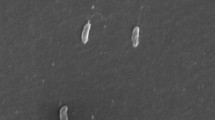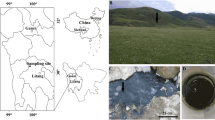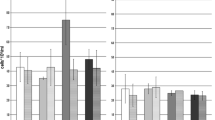Abstract
The purpose of this study was to identify bacteria that can perform As(III) oxidation for environmental bioremediation. Two bacterial strains, named JHS3 and JHW3, which can autotrophically oxidize As(III)–As(V) with oxygen as an electron acceptor, were isolated from soil and water samples collected in the vicinity of an arsenic-contaminated site. According to 16S ribosomal RNA sequence analysis, both strains belong to the ɤ-Proteobacteria class and share 99% sequence identity with previously described strains. JHS3 appears to be a new strain of the Acinetobacter genus, whereas JHW3 is likely to be a novel strain of the Klebsiella genus. Both strains possess the aioA gene encoding an arsenite oxidase and are capable of chemolithoautotrophic growth in the presence of As(III) up to 10 mM as a primary electron donor. Cell growth and As(III) oxidation rate of both strains were significantly enhanced during cultivation under heterotrophic conditions. Under anaerobic conditions, only strain JHW3 oxidized As(III) using nitrate or a solid-state electrode of a bioelectrochemical system as a terminal electron acceptor. Kinetic studies of As(III) oxidation under aerobic condition demonstrated a higher V max and K m from strain JHW3 than strain JHS3. This study indicated the potential application of strain JHW3 for remediation of subsurface environments contaminated with arsenic.







Similar content being viewed by others
References
Ai LN, Sato A, Inoue D, Sei K, Soda S, Ike M (2012) Enrichment of arsenite oxidizing bacteria under autotrophic conditions and the isolation and characterization of facultative chemolithoautotrophic arsenite oxidizing bacteria for removal of arsenic from groundwater. Water Sci Technol Water Supply 12:707–714. doi:10.2166/ws.2012.045
Bahar MM, Megharaj M, Naidu R (2012) Arsenic bioremediation potential of a new arsenite-oxidizing bacterium Stenotrophomonas sp. MM-7 isolated from soil. Biodegradation 23:803–812. doi:10.1007/s10532-012-9567-4
Bahar MM, Megharaj M, Naidu R (2013) Bioremediation of arsenic-contaminated water: recent advances and future prospects. Water Air Soil Pollut 224:1722. doi:10.1007/s11270-013-1722-y
Bahar MM, Megharaj M, Naidu R (2013) Kinetics of arsenite oxidation by Variovorax sp. MM-1 isolated from a soil and identification of arsenite oxidase gene. J Hazard Mater 262:997–1003. doi:10.1016/j.jhazmat.2012.11.064
Balch WE, Fox GE, Magrum LJ, Woese CR, Wolfe RS (1979) Methanogens: reevaluation of a unique biological group. Microbiol Rev 43:260–296
Battaglia-Brunet F, Dictor M-C, Garrido F, Crouzet C, Morin D, Dekeyser K, Clarens M, Baranger P (2002) An arsenic(III)-oxidizing bacterial population: selection, characterization, and performance in reactors. J Appl Microbiol 93:656–667. doi:10.1046/j.1365-2672.2002.01726.x
Berg M, Stengel C, Pham TKT, Pham HV, Sampson ML, Leng M, Samreth S, Fredericks D (2007) Magnitude of arsenic pollution in the Mekong and Red River Deltas—Cambodia and Vietnam. Sci Total Environ 372:413–425. doi:10.1016/j.scitotenv.2006.09.010
Bernhardt PV, Santini JM (2006) Protein film voltammetry of arsenite oxidase from the chemolithoautotrophic arsenite-oxidizing bacterium NT-26. Biochemistry 45:2804–2809. doi:10.1021/bi0522448
Butt AS, Rehman A (2011) Isolation of arsenite-oxidizing bacteria from industrial effluents and their potential use in wastewater treatment. World J Microbiol Biotechnol 27:2435–2441. doi:10.1007/s11274-011-0716-4
Chang J-S, Yoon I-H, Lee J-H, Kim K-R, An J, Kim K-W (2010) Arsenic detoxification potential of aox genes in arsenite-oxidizing bacteria isolated from natural and constructed wetlands in the Republic of Korea. Environ Geochem Health 32:95–105. doi:10.1007/s10653-009-9268-z
Chen W, Parette R, Zou J, Cannon FS, Dempsey BA (2007) Arsenic removal by iron-modified activated carbon. Water Res 41:1851–1858. doi:10.1016/j.watres.2007.01.052
Chitpirom K, Akaracharanya A, Tanasupawat S, Leepipatpiboon N, Kim KW (2009) Isolation and characterization of arsenic resistant bacteria from tannery wastes and agricultural soils in Thailand. Ann Microbiol 59:649–656. doi:10.1007/BF03179204
Choong TSY, Chuah TG, Robiah Y, Gregory Koay FL, Azni I (2007) Arsenic toxicity, health hazards and removal techniques from water: an overview. Desalination 217:139–166. doi:10.1016/j.desal.2007.01.015
Daware V, Kesavan S, Patil R, Natu A, Kumar A, Kulkarni M, Gade W (2012) Effects of arsenite stress on growth and proteome of Klebsiella pneumoniae. J Biotechnol 158:8–16. doi:10.1016/j.jbiotec.2011.12.013
Dong D, Ohtsuka T, Dong DT, Amachi S (2014) Arsenite oxidation by a facultative chemolithoautotrophic Sinorhizobium sp. KGO-5 isolated from arsenic-contaminated soil. Biosci Biotechnol Biochem 78:1963–1970. doi:10.1080/09168451.2014.940276
Drewniak L, Sklodowska A (2013) Arsenic-transforming microbes and their role in biomining processes. Environ Sci Pollut Res 20:7728–7739. doi:10.1007/s11356-012-1449-0
Ehrlich HL, Newman DK (2009) Geomicrobiology, 5th edn. CRC Press, New York
Garcia-Dominguez E, Mumford A, Rhine ED, Paschal A, Young LY (2008) Novel autotrophic arsenite-oxidizing bacteria isolated from soil and sediments. FEMS Microbiol Ecol 66:401–410. doi:10.1111/j.1574-6941.2008.00569.x
Garelick H, Dybowska A, Valsami-Jones E, Priest N (2005) Remediation technologies for arsenic contaminated drinking waters. J Soils Sediments 5:182–190. doi:10.1065/jss2005.06.140
Gossett JM (2010) Sustained aerobic oxidation of vinyl chloride at low oxygen concentrations. Environ Sci Technol 44:1405–1411. doi:10.1021/es9033974
Inskeep WP, Macur RE, Hamamura N, Warelow TP, Ward SA, Santini JM (2007) Detection, diversity and expression of aerobic bacterial arsenite oxidase genes. Environ Microbiol 9:934–943. doi:10.1111/j.1462-2920.2006.01215.x
Ito A, Miura J-I, Ishikawa N, Umita T (2012) Biological oxidation of arsenite in synthetic groundwater using immobilised bacteria. Water Res 46:4825–4831. doi:10.1016/j.watres.2012.06.013
Jain C, Ali I (2000) Arsenic: occurrence, toxicity and speciation techniques. Water Res 34:4304–4312. doi:10.1016/S0043-1354(00)00182-2
Jukes TH, Cantor CR (1969) Evolution of protein molecule. In: Munro HN (ed) Mamm. protein Metab. Academic Press, New York, pp 21–132
Liu L, Li FB, Feng CH, Li XZ (2009) Microbial fuel cell with an azo-dye-feeding cathode. Appl Microbiol Biotechnol 85:175–183. doi:10.1007/s00253-009-2147-9
Mandal BK, Suzuki KT (2002) Arsenic round the world: a review. Talanta 58:201–235. doi:10.1016/S0039-9140(02)00268-0
Masscheleyn PH, Delaune RD, Patrick WH (1991) Effect of redox potential and pH on arsenic speciation and solubility in a contaminated soil. Environ Sci Technol 25:1414–1419. doi:10.1021/es00020a008
Mattes A, Gould D, Taupp M, Glasauer S (2013) A novel autotrophic bacterium isolated from an engineered wetland system links nitrate-coupled iron oxidation to the removal of As, Zn and S. Water Air Soil Pollut 224:1490. doi:10.1007/s11270-013-1490-8
Neff JM (1997) Ecotoxicology of arsenic in the marine environment. Environ Toxicol Chem 16:917–927. doi:10.1002/etc.5620160511
Nguyen VK, Hong S, Park Y, Jo K, Lee T (2015) Autotrophic denitrification performance and bacterial community at biocathodes of bioelectrochemical systems with either abiotic or biotic anodes. J Biosci Bioeng 119:180–187. doi:10.1016/j.jbiosc.2014.06.016
Nguyen VK, Lee J-U (2014) Isolation and characterization of antimony-reducing bacteria from sediments collected in the vicinity of an antimony factory. Geomicrobiol J 31:855–861. doi:10.1080/01490451.2014.901440
Nguyen VK, Lee J-U (2015) Antimony-oxidizing bacteria isolated from antimony-contaminated sediment–a phylogenetic study. Geomicrobiol J 32:50–58. doi:10.1080/01490451.2014.925009
Paulo A (2014) Anaerobic degradation of anionic surfactants by denitrifying bacteria. Wageningen University, Wageningen
Pous N, Casentini B, Rossetti S, Fazi S, Puig S, Aulenta F (2015) Anaerobic arsenite oxidation with an electrode serving as the sole electron acceptor: A novel approach to the bioremediation of arsenic-polluted groundwater. J Hazard Mater 283:617–622. doi:10.1016/j.jhazmat.2014.10.014
Quéméneur M, Heinrich-Salmeron A, Muller D, Lièvremont D, Jauzein M, Bertin PN, Garrido F, Joulian C (2008) Diversity surveys and evolutionary relationships of aoxB genes in aerobic arsenite-oxidizing bacteria. Appl Environ Microbiol 74:4567–4573. doi:10.1128/AEM.02851-07
Rabaey K, Angenent L, Schroder U, Keller J (2010) Bioelectrochemical systems: from extracellular electron transfer to biotechnological application. IWA Publishing, London
Saitou N, Nei M (1987) The neighbor-joining method: a new method for reconstructing phylogenetic trees. Mol Biol Evol 4:406–425
Sánchez JA, Rivas BL, Pooley SA, Basaez L, Pereira E, Pignot-Paintrand I, Bucher C, Royal G, Saint-Aman E, Moutet J-C (2010) Electrocatalytic oxidation of As(III) to As(V) using noble metal–polymer nanocomposites. Electrochim Acta 55:4876–4882. doi:10.1016/j.electacta.2010.03.080
Santini JM, Sly LI, Schnagl RD, Macy JM (2000) A new chemolithoautotrophic arsenite-oxidizing bacterium isolated from a gold mine: phylogenetic, physiological, and preliminary biochemical studies. Appl Environ Microbiol 66:92–97. doi:10.1128/AEM.66.1.92-97.2000
Smith AH, Hopenhayn-Rich C, Bates MN, Goeden HM, Hertz-Picciotto I, Duggan HM, Wood R, Kosnett MJ, Smith MT (1992) Cancer risks from arsenic in drinking water. Environ Health Perspect 97:259–267
Thompson JD, Higgins DG, Gibson TJ (1994) CLUSTAL W: improving the sensitivity of progressive multiple sequence alignment through sequence weighting, position-specific gap penalties and weight matrix choice. Nucleic Acids Res 22:4673–4680
Vadahanambi S, Lee S-H, Kim W-J, Oh I-K (2013) Arsenic removal from contaminated water using three-dimensional graphene-carbon nanotube-iron oxide nanostructures. Environ Sci Technol 47:10510–10517. doi:10.1021/es401389g
WHO (2011) Arsenic in drinking water. WHO Press, Geneva
Winkel LHE, Pham TKT, Vi ML, Stengel C, Amini M, Nguyen TH, Pham HV, Berg M (2011) Arsenic pollution of groundwater in Vietnam exacerbated by deep aquifer exploitation for more than a century. Proc Natl Acad Sci U S A 108:1246–1251. doi:10.1073/pnas.1011915108
Zhang J, Zhou W, Liu B, He J, Shen Q, Zhao F-J (2015) Anaerobic arsenite oxidation by an autotrophic arsenite-oxidizing bacterium from an arsenic-contaminated paddy soil. Environ Sci Technol 49:5956–5964. doi:10.1021/es506097c
Zhang L, Zhou S, Zhuang L, Li W, Zhang J, Lu N, Deng L (2008) Microbial fuel cell based on Klebsiella pneumoniae biofilm. Electrochem Commun 10:1641–1643. doi:10.1016/j.elecom.2008.08.030
Zuckerlandl E, Pauling L (1965) Evolving genes and proteins. Evol Genes Proteins. doi:10.1016/B978-1-4832-2734-4.50017-6
Acknowledgements
This work was supported by the Financial Supporting Project of Long-term Overseas Dispatch of PNU’s Tenure-track Faculty, 2013.
Author information
Authors and Affiliations
Corresponding author
Ethics declarations
Conflict of interest
The authors declare no conflict of interest.
Ethical statement
This article does not contain any studies with human participants or animals performed by any of the authors.
Electronic supplementary material
Below is the link to the electronic supplementary material.
Rights and permissions
About this article
Cite this article
Nguyen, V.K., Tran, H.T., Park, Y. et al. Microbial arsenite oxidation with oxygen, nitrate, or an electrode as the sole electron acceptor. J Ind Microbiol Biotechnol 44, 857–868 (2017). https://doi.org/10.1007/s10295-017-1910-7
Received:
Accepted:
Published:
Issue Date:
DOI: https://doi.org/10.1007/s10295-017-1910-7




